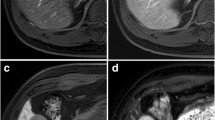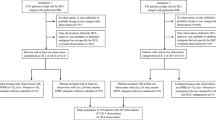Abstract
Purpose
We compared the diagnostic performances of the European Association for the Study of the Liver (EASL) 2018 and Liver Imaging Reporting and Data System (LI-RADS) 2018 criteria on magnetic resonance imaging (MRI) for the noninvasive diagnosis of hepatocellular carcinoma (HCC) in high-risk patients and evaluated the difference in diagnostic value between MRI with extracellular contrast agents (ECA-MRI) and MRI with hepatobiliary agents (HBA-MRI).
Methods
This study included 382 observations from 298 patients at high risk for HCC who underwent preoperative multiphasic contrast-enhanced MRI between January 2015 and December 2016. Two readers assessed all observations according to the EASL 2018 and LI-RADS 2018 criteria, and the per-observation diagnostic performances were compared.
Results
On ECA-MRI, the LR-5 category of LI-RADS 2018 showed significantly higher sensitivity (78.9% vs. 71.5%, p = 0.005) and accuracy (81.7% vs. 75.0%, p = 0.003) for the diagnosis of HCC than the EASL 2018. On HBA-MRI, the diagnostic performances of the EASL 2018 and LR-5 of LI-RADS 2018 were not significantly different. When using EASL 2018, no statistically significant differences were observed in the diagnostic performances between ECA-MRI and HBA-MRI; however, when using the LR-5 of LI-RADS 2018, ECA-MRI had a higher sensitivity (78.9% vs. 67.5%, p = 0.029) than HBA-MRI.
Conclusions
On ECA-MRI, the LR-5 category of LI-RADS 2018 provides better sensitivity and accuracy than the EASL 2018 for diagnosing HCC. EASL 2018 provides comparable diagnostic performances between ECA-MRI and HBA-MRI, but the LR-5 category of LI-RADS 2018 provides better sensitivity on ECA-MRI than on HBA-MRI.


Similar content being viewed by others
Data availability statement
The data that support the findings of this study are available from the corresponding author upon reasonable request.
References
Bruix J, Sherman M, Llovet JM, et al. Clinical management of hepatocellular carcinoma. Conclusions of the Barcelona-2000 EASL conference. European Association for the Study of the Liver. J Hepatol 2001;35:421–430
European Association for the Study of the Liver. EASL Clinical practice guidelines: management of hepatocellular carcinoma. J Hepatol 2018;69:182–236
CT/MRI LI-RADS® v2018. 2018. https://www.acr.org/Clinical-Resources/Reporting-and-Data-Systems/LI-RADS/CT-MRI-LI-RADS-v2018. Accessed 8 Aug 2018
Marrero JA, Kulik LM, Sirlin CB, et al. Diagnosis, staging, and management of hepatocellular carcinoma: 2018 practice guidance by the American Association for the Study of Liver Diseases. Hepatology 2018;68:723–750
Ronot M, Fouque O, Esvan M, Lebigot J, Aube C, Vilgrain V. Comparison of the accuracy of AASLD and LI-RADS criteria for the non-invasive diagnosis of HCC smaller than 3 cm. J Hepatol 2018;68:715–723
Allen BC, Ho LM, Jaffe TA, Miller CM, Mazurowski MA, Bashir MR. Comparison of visualization rates of LI-RADS Version 2014 major features with IV gadobenate dimeglumine or gadoxetate disodium in patients at risk for hepatocellular carcinoma. AJR Am J Roentgenol 2018;210:1266–1272
Song JS, Choi EJ, Hwang SB, Hwang HP, Choi H. LI-RADS v2014 categorization of hepatocellular carcinoma: intraindividual comparison between gadopentetate dimeglumine-enhanced MRI and gadoxetic acid-enhanced MRI. Eur Radiol 2019;29:401–410
Min JH, Kim JM, Kim YK, et al. Prospective intraindividual comparison of magnetic resonance imaging with gadoxetic acid and extracellular contrast for diagnosis of hepatocellular carcinomas using the liver imaging reporting and data system. Hepatology 2018;68:2254–2266
Ding Y, Rao SX, Wang WT, Chen CZ, Li RC, Zeng M. Comparison of gadoxetic acid versus gadopentetate dimeglumine for the detection of hepatocellular carcinoma at 1.5 T using the liver imaging reporting and data system (LI-RADS v.2017). Cancer Imaging 2018;18:48
Dioguardi Burgio M, Picone D, Cabibbo G, Midiri M, Lagalla R, Brancatelli G. MR-imaging features of hepatocellular carcinoma capsule appearance in cirrhotic liver: comparison of gadoxetic acid and gadobenate dimeglumine. Abdom Radiol (NY) 2016;41:1546–1554
Santillan C, Fowler K, Kono Y, Chernyak V. LI-RADS major features: CT, MRI with extracellular agents, and MRI with hepatobiliary agents. Abdom Radiol (NY) 2018;43:75–81
Abd Alkhalik Basha M, Abd El Aziz El Sammak D, El Sammak AA. Diagnostic efficacy of the Liver Imaging-Reporting and Data System (LI-RADS) with CT imaging in categorising small nodules (10–20 mm) detected in the cirrhotic liver at screening ultrasound. Clin Radiol 2017;72:901 e901-901 e911
An C, Park S, Chung YE, et al. Curative resection of single primary hepatic malignancy: liver imaging reporting and data system category LR-M portends a worse prognosis. AJR Am J Roentgenol 2017;209:576–583
Cha DI, Jang KM, Kim SH, Kang TW, Song KD. Liver imaging reporting and data system on CT and gadoxetic acid-enhanced MRI with diffusion-weighted imaging. Eur Radiol 2017;27:4394–4405
Kim BR, Lee JM, Lee DH, et al. Diagnostic performance of gadoxetic acid-enhanced liver MR imaging versus multidetector CT in the detection of dysplastic nodules and early hepatocellular carcinoma. Radiology 2017;285:134–146
Fraum TJ, Tsai R, Rohe E, et al. Differentiation of hepatocellular carcinoma from other hepatic malignancies in patients at risk: diagnostic performance of the liver imaging reporting and data system version 2014. Radiology 2018;286:158–172
Kim YY, An C, Kim S, Kim MJ. Diagnostic accuracy of prospective application of the liver imaging reporting and data system (LI-RADS) in gadoxetate-enhanced MRI. Eur Radiol 2018;28:2038–2046
Liu W, Qin J, Guo R, et al. Accuracy of the diagnostic evaluation of hepatocellular carcinoma with LI-RADS. Acta Radiol 2018;59:140–146
Alhasan A, Cerny M, Olivie D, et al. LI-RADS for CT diagnosis of hepatocellular carcinoma: performance of major and ancillary features. Abdom Radiol (NY) 2019;44:517–528
Joo I, Lee JM, Lee DH, Jeon JH, Han JK. Retrospective validation of a new diagnostic criterion for hepatocellular carcinoma on gadoxetic acid-enhanced MRI: can hypointensity on the hepatobiliary phase be used as an alternative to washout with the aid of ancillary features? Eur Radiol 2019;29:1724–1732
Kierans AS, Makkar J, Guniganti P, et al. Validation of liver imaging reporting and data system 2017 (LI-RADS) Criteria for imaging diagnosis of hepatocellular carcinoma. J Magn Reson Imaging 2019;49:e205–e215
Ren AH, Zhao PF, Yang DW, Du JB, Wang ZC, Yang ZH. Diagnostic performance of MR for hepatocellular carcinoma based on LI-RADS v2018, compared with v2017. J Magn Reson Imaging 2019;50:746–755
Renzulli M, Biselli M, Brocchi S, et al. New hallmark of hepatocellular carcinoma, early hepatocellular carcinoma and high-grade dysplastic nodules on Gd-EOB-DTPA MRI in patients with cirrhosis: a new diagnostic algorithm. Gut 2018;67:1674–1682
Rosiak G, Podgorska J, Rosiak E, Cieszanowski A. Comparison of LI-RADS vol 2017 and ESGAR guidelines imaging criteria in HCC diagnosis using MRI with hepatobiliary contrast agents. Biomed Res Int 2018;2018:7465126
Zhang T, Huang ZX, Wei Y, et al. Hepatocellular carcinoma: can LI-RADS v2017 with gadoxetic-acid enhancement magnetic resonance and diffusion-weighted imaging improve diagnostic accuracy? World J Gastroenterol 2019;25:622–631
van der Pol CB, Lim CS, Sirlin CB, et al. Accuracy of the liver imaging reporting and data system in computed tomography and magnetic resonance image analysis of hepatocellular carcinoma or overall Malignancy: a systematic review. Gastroenterology 2019;156:976–986
Funding
This study was supported by a grant from the National R&D Program for Cancer Control, Ministry of Health and Welfare, Korea (Grant No. 1520160).
Author information
Authors and Affiliations
Contributions
All authors participated in the following: substantial contributions to the conception or design of the work; or the acquisition, analysis, or interpretation of data; drafting the work or revising it critically for important intellectual content; approval of the final version of the manuscript; agreement to be accountable for all aspects of the work in ensuring that questions related to the accuracy or integrity of any part of the work are appropriately investigated and resolved. The main role of the authors was as follows: 1. guarantor of the integrity of the entire study: M-JK. 2. Study conception and design: SL, M-JK, and SK. 3. Literature search: SL. 4. Clinical studies: SK, DYK, JYC, and MP. 5. Data analysis or interpretation: SK, SL, M-JK, and DGM. 6. Statistical analysis: HS. 7. Manuscript preparation: SL and M-JK. 8. Manuscript review: SL, M-JK, and DGM. 9. Study supervision: DGM.
Corresponding author
Ethics declarations
Conflict of interest
Sunyoung Lee, Seung-seob Kim, Hyejung Shin, Do Young Kim, Jin-Young Choi, Mi-Suk Park, and Donald G. Mitchell declare that they have no conflict of interest. Myeong-Jin Kim received grant and honorarium from Bayer, and honorarium from Guerbet, Philips, SIEMENS, and GE Healthcare.
Ethical approval
This e study was approved by the Severance Hospital, Yonsei University College of Medicine, IRB Number 4-2018-1090).
Informed consent
The written or oral informed consent was waived.
Additional information
Publisher's Note
Springer Nature remains neutral with regard to jurisdictional claims in published maps and institutional affiliations.
Electronic supplementary material
Below is the link to the electronic supplementary material.
Rights and permissions
About this article
Cite this article
Lee, S., Kim, MJ., Kim, Ss. et al. Retrospective comparison of EASL 2018 and LI-RADS 2018 for the noninvasive diagnosis of hepatocellular carcinoma using magnetic resonance imaging. Hepatol Int 14, 70–79 (2020). https://doi.org/10.1007/s12072-019-10002-3
Received:
Accepted:
Published:
Issue Date:
DOI: https://doi.org/10.1007/s12072-019-10002-3




